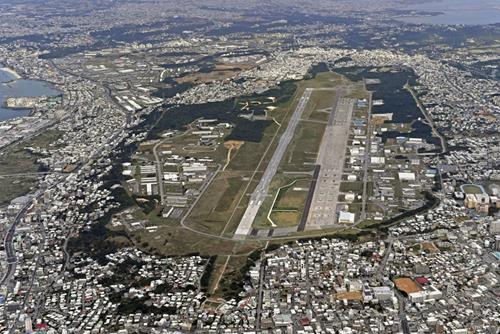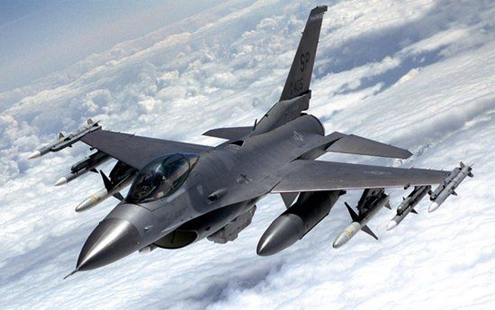Outbreaks, burning warships, dropping planes … This summer, the US military is really annoying!
A collective COVID-19 infection broke out at the US military base in Okinawa, and the US Navy’s "Good Richard" amphibious assault ship burst into flames, and the US Air Force crashed an F-16C… …
This summer, American troops deployed in many parts of the world have frequent accidents and troubles!

This is the Futenma base of the US military stationed in Japan in Okinawa, Japan, which was photographed on January 27, 2018. Xinhua News Agency/Midland
Make people angry! Aggregative COVID-19 outbreak broke out at the US military base in Japan.
Recently, a collective COVID-19 infection suddenly appeared in the US military base in Okinawa. Only from July 7th to 11th, there were 61 confirmed cases of COVID-19 in the U.S. military base in Okinawa, and on the 13th, the U.S. military base in Okinawa notified 32 confirmed cases to the local area. On the 15th, the Okinawa prefectural government of Japan confirmed that there were 36 new confirmed cases of COVID-19 in several local US military bases in Japan.
A large number of confirmed cases appeared in a short period of time. Danny Yucheng, the governor of Okinawa Prefecture, was "shocked" and "extremely sorry" about the news, and said that he "had to have strong doubts about the epidemic prevention countermeasures".
It is reported that more than half of the 50,000 US troops stationed in Japan and the United States are stationed in Okinawa, and they are not subject to Japanese Covid-19 inspection, and the US military’s epidemic prevention measures are not controlled by the Japanese side.
It is even more reported that the US was initially reluctant to disclose information such as the number of confirmed cases of US troops stationed in Japan and the whereabouts of confirmed cases. Later, at the repeated request of the Japanese side, it had to publish relevant information.
American soldiers who enjoy "special status" are "free to come and go" and "go their own way" in Okinawa. Some Okinawa residents said that during the epidemic, they were really worried when they saw American soldiers without masks on the street.
For a long time, Okinawa residents have complained about the noise and pollution caused by the US military base, the crash of US military aircraft, and crimes committed by US military personnel. The outbreak of the cluster epidemic has intensified their dissatisfaction.
Too bad! The US Navy’s "quasi-aircraft carrier" is in full swing
Something happened to the US military base in Japan on the west coast of the Pacific Ocean, and the US naval base on the east coast was not "peaceful".
On July 12th, local time, the "Good Richard" of amphibious assault ship, moored at the naval base in San Diego, USA, exploded and burst into flames. For a time, the pungent smoke produced by the burning of plastics, cables and other materials floated all over the center of San Diego, and many sailors who escaped from the ship also lost all their property, "only a suit of clothes."

On July 12, the naval base in San Diego, California, USA caught fire and emitted smoke. A fire broke out on the 12th in amphibious assault ship, a US military vessel moored at the San Diego Naval Base in California. Xinhua News Agency/Midland
According to the US Navy, as of the afternoon of the 13th, 36 sailors and 23 civilians had been treated for high temperature burns and smoke inhalation.
Good Richard is one of the American Navy’s wasp-class amphibious assault ship ships, with a displacement of over 40,000 tons. It has a spacious flight deck and hangar deck, which can accommodate helicopters, tilt-rotor aircraft and short-range take-off and landing aircraft, and is equivalent to a quasi-aircraft carrier.
Although the name is very special, many people will not be unfamiliar with the ship. In the popular sci-fi movie Super Battleship a few years ago, people have experienced the elegance of this big ship.
Before the fire, the ship was under medium-term maintenance, mainly upgrading the flight deck. After the upgrade, it will be able to carry at most 16 F-35B short takeoff/vertical landing fighters or 22 MV-22B Osprey transport planes.
This fire, which lasted for dozens of hours, may make it difficult for this huge ship with a ship age of more than 20 years to regain its glory. Some analysts pointed out that although the damage degree of the ship is still unclear, the intensity of the fire is enough to deform the structural steel of the hull. Considering the damage degree, the ship will stop using for at least several years, and it is likely to be identified as completely scrapped. Once the ship is scrapped, it will be "the most serious safety accident of the US Navy in the past 20 years" with heavy losses.
What a jam! The U.S. Air Force recently destroyed another plane.
It rained all night, and the fire on the "Good Richard" has not been extinguished, and the Air Force has "added a wall" to the US military.
On July 13th, local time, an F-16C fighter plane crashed at holloman Air Force Base in New Mexico.

Data Map: US Air Force F-16C Fighter
However, this plane crash is not the only one this year. Since May, there have been many crashes in the US Air Force, including the tragedy of "the plane crashed and people died".
On May 15th, an F-22 fighter plane of the US Air Force crashed near Eglin Air Force Base in Florida, and the pilot ejected to escape.
On May 20th, Eglin Air Force Base confirmed that an F-35A fighter plane crashed while trying to land at the base on the evening of 19th, and the pilot also ejected to escape.
On June 15th, an F-15C fighter plane crashed during a training mission at the US military base in Britain.
On June 30, an F-16 fighter jet crashed while performing daily training tasks at Shaw Air Force Base in Southern California, USA. The pilot on board was taken to the hospital and was later declared brain dead.
In less than two months, several "Hawk" aircraft with high cost and outstanding performance "lost their wings" in training, and the loss was not insignificant.